The Golden Hind
In
1902
a
water
chute
was
built
alongside
the
Eastern
side
of
the
pier
pavilion,
riders
would
leave
the
launch
platform
located
on
top of the pier pavilion and dive into a specially built sea water basin, the water was changed with every high tide.

Southend Timeline Southend-on-Sea © 2009 - 2024. All Rights Reserved

Southend-on-Sea
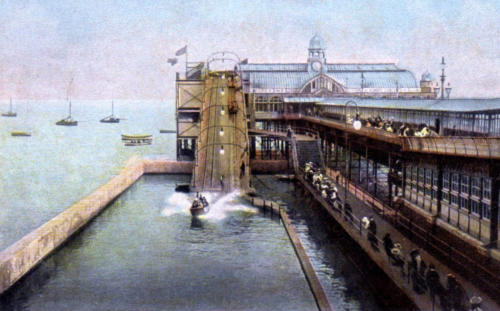
The
start
of
the
Second
World
War
saw
Southend
seafront
closed
to
civilians.
When
peace
returned
a
major
refurbishment
of
the
pier
was
undertaken,
new
trains
were
ordered,
and
the
old
pool
along
side
was
also
given
a
new
lease
of
life.
A
Southend
based
company
were
contracted
to
build
a
new
attraction,
a
stipulation
of
the
contract
stated
that
all
employees
working
on
the
new
attraction
must
be
unemployed
Southend
seamen.
Construction
started
in
1947
and
continued
through
to
1948
with
work
being
completed
before
the
start
of
the
1949
season.
The
new
attraction
was
a
full
size
replica
of
the
Golden
Hind
sailing
ship
used
by
Sir
Frances Drake to sail round the world.
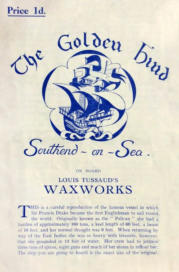
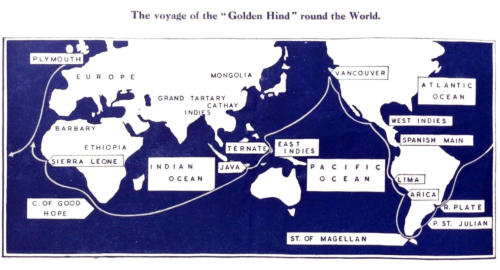
Two views of the the Golden Hind photographed in the early 1990s
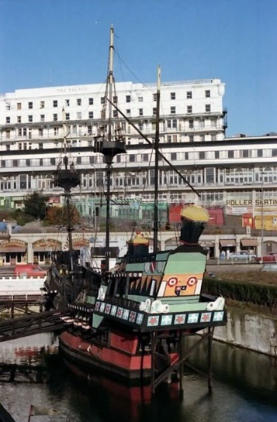
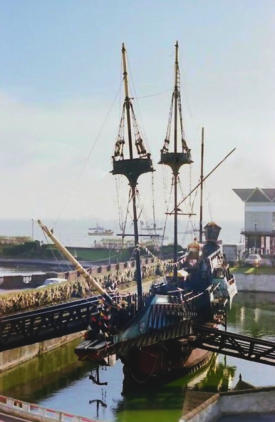
The
replica
ship
housed
a
waxworks
exhibition,
the
attraction
proved
popular
but
by
1992
visitor
numbers
had
dropped,
also
the
wooden
structure
was
beginning
to
deteriorate
and
was
in
need
of
renovation,
this
brought
the
whole
future
of
the
landmark
into
question,
a
proposal
to
demolish
the
ship
and
replace
it
with
a
"Waikiki
Wave"
white
knuckle
thrill
ride
were
proposed
but
nothing
ever
became
of
the
plans
and
they
quietly
washed
away.
In
1997
the
Golden
Hind
closed.
The
ship
was
then
bought
by
the
operators
of
Peter
Pans/Adventure
Island.
After
a
structural
survey,
it
was
found
the
ship
needed
a
major
rebuilding
program
to
safely
re-open
again,
the
cost
of
restoration
was
so
high,
the
ship
was
scrapped.
A
replacement
ship
was
built,
the
“Queen
Anne’s
Revenge”
which
this
time
was
a
replica
of
the
ship
used
by
the notorious English pirate Blackbeard, it formed the centre piece of the Blackbeard Revenge attraction.
On
Tuesday
8th
January
2013
the
replica
pirate
ship
the
Queen
Anne's
Revenge
was
demolished,
this
brought
an
end
of
the
era
of
a
"tall
ship"
being
based
on
Southend
Seafront.
The
site
was
redeveloped
as
a
part of Southend’s Adventure Island.
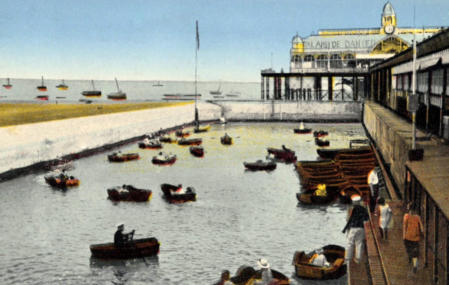
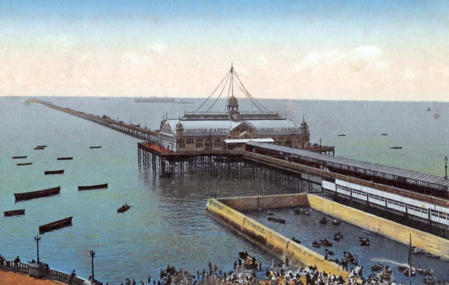

Sir Francies Drake and the Golden Hind
Drake
wished
to
reach
the
Pacific
and
attack
Spain
in
waters
where
she
never
expected
to
find
hostile
ships.
Queen
Elizabeth
secretly
supported
him
and
contributed
1,000
crowns
to
the
expedition,
but
the
Peace
party
of
the
day
were
hostile
to
his
plans
and
one
of
their
number,
Thomas
Doughty,
a
sort
of
Elizabethan
saboteur,
joined
the
expedition
with
the
express
purpose
of
wrecking
it.
Drake
dealt
with
him,
however,
and
beheaded
him
at
Port
St.
Julian,
in
sight
of
the
gibbet
where
Magellan
had
ended
a
mutiny
nearly
sixty
years before.
In
mid-December,
1577,
the
Golden
Hind
left
Plymouth
on
her
great
adventure.
In
company
with
her
were
the
Elizabeth,
80
tons,
16
guns,
commanded
by
John
Winter:
the
Marigold,
30
tons,
and
a
victualling
ship
of
50
tons
named
the
Swan,
commanded
by
John
Thomas. The smallest vessel in the flotilla was the Benedict pinnace, 15 tons, commanded by carpenter, Thomas Moone.
There
were
164
men
and
boys
in
the
squadron,
the
Golden
Hind
herself
having
a
complement
of
80
men
and
8
boys.
Before
a
year
was
out
her
company
was
reduced
by
the
appalling
conditions
experienced
by
everyone
who
ventured
to
sea
in
those
adventurous
days to a total of 59.
Only
three
vessels
won
through
the
Strait
of
Magellan
to
the
Pacific,
the
Hind,
the
Elizabeth
and
the
Marigold.
Shortly
after
the
Marigold was lost with all hands in a great Storm, and the Elizabeth, believing that Drake was lost, sailed back to England.
But
Drake
was
far
from
being
dead.
He
had
reached
his
appointed
scene
of
operations.
He
began
a
series
of
raids
on
Spanish
towns,
and
captured
ship
after
ship,
until
his
name
became
a
word
of
terror
on
the
whole
western
seaboard
of
South
America.
His
crowning
achievement was the capture of the great treasure ship Cacafuego.
Drake
had
raised
such
a
hornet’s
nest
in
his
rear
that
he
gave
up
all
idea
of
returning
to
England
by
way
of
the
Magellan
Strait,
and
decided
instead
to
cross
the
Vast
Pacific.
But
before
this
was
possible
he
had
to
find
a
safe
harbour
in
which
to
careen
his
travel-worn
vessel.
He
sailed
as
far
north
as
Vancouver
endeavouring
to
find
such
a
haven,
and
with
the
idea
of
discovering
the
Western
outlet
of
the
North
West
Passage,
in
which
all
seamen
believed
implicitly
for
many
centuries,
but
the
cold
weather
he
encountered
had
a
bad
effect on his crew. So he turned south again, and finally anchored in what is to-day the great harbour of San Francisco.
Here
he
was
met
with
awe
and
worship
by
the
natives.
It
is
curious
to
reflect
that
Drake
probably
walked
over
the
ground
which
is
now
Hollywood,
and
was
entertained
by
the
local
inhabitants
to
spectacles
which
would
look
very
like
Wild
Westerns
to
our
modern
eyes.
He
took
over
the
land
in
the
name
of
Queen
Elizabeth
and
named
it
New
Albion,
and
a
brass
plate
which
he
left
behind
him
to
commemorate this event is still preserved. So even California was once an English Possession.
Then
came
the
long
voyage
across
the
vast
Western
Ocean,
in
a
ship
laden
with
treasure
later
to
be
valued
at
eight
hundred
thousand
pounds.
The
intrepid
voyagers
reached
the
East
Indies
safely
and
then
headed
for
Java.
Being
fearful
of
interception
and
the
loss
of
their
cargo,
they
then
set
sail
on
one
of
the
longest
non-stop
trips
ever
attempted
in
a
sailing
ship,
right
across
the
Indian
Ocean,
round
the
Cape
of
Good
Hope
and
up
the
West
African
coast
until
they
reached
Sierra
Leone,
where
they
stopped
for
the
first
fresh
water they had had for many months.
Drake
landed
at
Plymouth
on
3rd
November
1580,
three
long
years
after
setting
out
on
this
perilous
adventure,
to
be
greeted
with
amazement by people who had long given him up for dead.
Naturally,
the
Queen
wanted
to
see
Drake,
and
the
Golden
Hind
sailed
to
the
Thames
and
anchored
at
Deptford.
Here
the
Queen
knighted
him
in
the
great
after
cabin.
For
many
years
after
this
proud
vessel
rode
the
waters
of
the
Thames
until
she
finally
fell
to
pieces and was lost for ever.
1902 Water Chute next to the Pier
Later as a Boating Pool
Another view as a Boating Pool
However,
the
venture
only
last
for
a
few
years,
the
chute
was
removed
and
the
basin
became
a
boating
pool
for
a
short
time,
which after became sea water pool for swimming.
Map of Drakes Travels
Leaflet for the Attraction
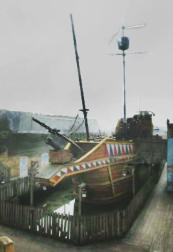
24th
March
2012
Queen
Anne’s Revenge

Southend-on-Sea’s No 1 History Website! Documenting The Town & The Townspeople

Now Incorporating The Sea Of Change Website
Website Info:


Chalkwell ▪ Eastwood ▪ Leigh-on-Sea ▪ Prittlewell ▪ Shoeburyness ▪ Southchurch ▪ Thorpe Bay ▪ Westcliff-on-Sea
SOUTHEND CITY
































































